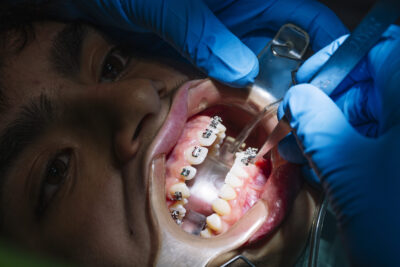
When choosing an orthodontic treatment to straighten teeth, patients tend to choose between two common and established options: traditional metal braces and Invisalign aligners.
Both metal braces and Invisalign aligners have a long history of effective teeth straightening over time. Straight teeth lead to a newfound spike in self-confidence and better overall oral health, but the best orthodontic treatment to straighten your teeth is completely individualized.
Conventional braces and Invisalign aligners each have a distinctive treatment process, treatment plan, and potential considerations like food restrictions. Therefore, an in-depth initial consultation is required to determine the right path and treatment plan for your unique oral health needs.
Many patients are unfamiliar with Invisalign technology when it comes to teeth straightening options. That’s why it’s helpful to have a solid understanding of how the Invisalign treatment process works and what to expect along the way.
Remember that you can get all your oral health questions answered during your initial consultation with Pannu Dental Group. We’ll work with you to ensure your treatment plan is comfortable and convenient and results in your dream smile.
Table of Contents
The Invisalign Treatment Process
How Long Does Invisalign Take?
How Much Does Invisalign Treatment Cost?
Invisalign Versus Traditional Braces
Deciding Between Braces and Invisalign Treatment
How Does Invisalign Work to Straighten Teeth?
Invisalign is a modern treatment used to address a range of orthodontic issues and primarily to reposition teeth over time into a straighter smile. The Invisalign treatment uses a series of custom-made and clear aligners that gradually move your teeth into their desired positions.
Unlike traditional metal braces, which rely on brackets and wires to straighten teeth over time, Invisalign aligners are constructed out of smooth and virtually invisible plastic that can be removed at any time, like wearing retainers.
Invisalign aligners may seem like a brand-new treatment, especially compared to traditional braces. However, the Invisalign treatment has been time-tested for decades.
The Invisalign treatment was developed in the late 1990s by Stanford University students after a student – Zia Chishti – had his metal braces removed and switched to a retainer. The group used modern treatment planning software – including CAD modeling and 3D printers – to create a brand-new tooth straightening treatment that could model a person’s optimal bite and develop a series of clear aligners to slowly move teeth into a desired position.
The FDA approved Invisalign in 1998, and it has been a common technology and treatment for straightening teeth ever since.
The Invisalign Treatment Process
Step 1 – your initial consultation with your dentist
The Invisalign process starts with an initial consultation with your dentist to discuss the Invisalign process step by step.
Step 2 – Using technology to take detailed impressions of your teeth.
Once you have approved and are comfortable with your Invisalign treatment plan, your dentist will take detailed impressions of your teeth through photographs, 3D imaging, X-rays, and/or other advanced treatment planning software. This step is crucial because it creates a clear blueprint for straight teeth and a confident smile.
Step 3 – Creating your new aligners
With this detailed data, your dentist will create a custom aligner and treatment plan for your teeth =. (The timeline can vary, but it generally takes about two weeks for Invisalign aligners to be created.) Based on a digital model, you’ll soon have your virtually invisible aligners ready to wear. Furthermore, your dentist will give you detailed instructions on how Invisalign works and how to wear and care for your Invisalign aligners.
Patients may need supplemental treatments in complex cases, such as adding small composite patches to the teeth, to allow the Invisalign process to work smoothly. Again, your dentist will explain any unique aspects of the Invisalign process for your specific needs, including supplemental or additional treatments to benefit your oral health.
Step 4 – The treatment time
As your Invisalign treatment progresses, you may periodically need a new aligner with new specifications as your straight teeth come to fruition and start to align in their final position.
Simply put, regular check-ups are required to ensure your Invisalign treatment works as it should and to determine if you’re ready for a new aligner.
Sometimes, patients may need additional care and maintenance steps after the Invisalign treatment is complete, such as wearing Vivera retainers. However, your dentist will explain these steps to keep your teeth straight early in the treatment process, and likely at your initial consultation.
How Long Does Invisalign Take?
One of the most common questions by patients who are considering Invisalign braces versus traditional braces is “How long does Invisalign take?” and the answer is not always straightforward.
Invisalign works through an individualized treatment, so the wear time varies for all patients.
The Invisalign process can take anywhere from six months to roughly two years, depending on the patient’s unique oral health needs and the severity of their orthodontic issues.
The average Invisalign process is around 12-18 months, but remember, you may need to take additional steps after the Invisalign process is complete to ensure your brilliant new smile thrives (like wearing retainers.)
How Much Does Invisalign Treatment Cost?
Again, the Invisalign treatment cost can vary substantially, depending on the orthodontist-recommended Invisalign treatment plan. The cost of Invisalign aligners is comparable to metal braces, and insurance coverage may be a viable option to mitigate this cost.
Your orthodontist will cover your varying treatment options to straighten teeth and can even help you discuss your treatments with your insurance provider. We can also help you explore your cost options so you can ensure that Invisalign works within your budget.
Invisalign Versus Traditional Braces
Both Invisalign aligners and traditional braces work to straighten teeth over time without damaging or affecting your other teeth. However, there are clear differences between these two treatments.
Invisalign Versus Braces – The Basics
- Invisalign aligners are made of a custom-created and clear plastic material, and these aligners are removable and are worn daily to gradually move teeth over time.
- Traditional metal braces are effectively a collection of metal wires and metal brackets affixed to the teeth, so they are a permanent part of your smile for however long they need to be worn.
Invisalign Versus Braces – The Cost
Metal braces and Invisalign braces (or aligners) have a similar cost and may be covered by your dental insurance provider.
Invisalign Versus Braces – The Treatment
Invisalign braces and traditional braces are designed to gradually move your teeth into a designated straight position over time. The treatment timeframe for both Invisalign aligners and braces can vary but can generally be anywhere from six months to two years for both treatments.
As a rule of thumb, Invisalign aligners tend to have a shorter treatment timeframe. In addition, Invisalign takes an average of 12-24 months of wear time. Braces take an average of 18-24 months to complete the treatment process, but this is different for every patient.
Invisalign Treatment Versus Braces – The Pros and Cons
Need a little clarification of how Invisalign works compared to metal braces, from your first trip to the dentist to your final smile? Here’s a summary of the pros and cons of an Invisalign treatment versus traditional braces
How Invisalign Works – The Pros
- Since Invisalign is a clear aligner, it minimizes any self-consciousness throughout the treatment process. Virtually invisible, as the name aptly implies, you’ll have a beautiful smile from day one, as your aligner is clear and unnoticeable, as opposed to braces.
- Invisalign aligners are also completely removable, which means you can take them out to brush your teeth and eat meals without any hindrance or extra steps. (For example, with metal braces, you may need special tools to brush your teeth effectively, and you’ll need to avoid certain foods that can get stuck in the metal brackets and metal wires.)
- If your Invisalign aligners are damaged or lost, it’s easy to have them replaced. This may result in an uptick in the overall cost. However, it won’t require an emergency trip to the dentist’s office, which may be necessary if your permanent metal braces suddenly sustain damage.
- The Invisalign treatment is highly effective in straightening your teeth and usually has a shorter treatment timeframe than braces.
How Invisalign Works – The Cons
- Invisalign works by gradually moving the teeth into their desired position to create a gorgeous smile. However, this treatment is only effective if you wear your Invisalign aligners for the recommended amount of time every day (usually 20-22 hours.) If you don’t stick to this schedule and take your aligner out more often and longer than you should, the Invisalign treatment may take longer or be less effective.
- Because Invisalign aligners are removable, they can certainly be lost or misplaced, and you will need to get a new set of aligners from your dentist.
- After your Invisalign treatment, you may need to wear retainers for the long term to ensure that your teeth straightening treatment is a permanent solution.
Traditional braces – The Pros
- Traditional braces are permanently affixed to your teeth for the duration of your treatment. Therefore, you don’t need to worry about losing or misplacing your braces, like with a clear aligner.
- Traditional metal braces may be a better option for patients with severe or complex oral health issues, than Invisalign aligners. They can handle more complex orthodontic problems like severe crowding, deep bites, or misaligned jaws.
- Metal braces may be better for younger patients simply because an Invisalign clear aligner requires a bit of diligence to work effectively. You need to wear an Invisalign aligner for 20-22 hours a day, every day. Therefore, maintaining this strict schedule can be difficult for younger patients.
Traditional braces – The Cons
- As opposed to a clear Invisalign aligner, traditional metal braces are inherently noticeable, as they consist of a series of wires and brackets that are attached to your teeth. As a result, patients, especially adults, might be a bit more self-conscious about their smiles during the treatment timeframe for braces.
- Because metal braces are complex, intricate, and permanently affixed, you’ll need to use caution when conducting everyday activities like eating meals or when brushing your teeth. Certain foods will also be off-limits for the duration of your treatment, like soft candy or popcorn that can get stuck in your braces or hard foods that can cause a metal bracket or wire to break.
- If you sustain damage to your braces, you’ll likely need to make an emergency trip to your dentist’s office to repair them.
- Many patients state that braces can be a little more uncomfortable than Invisalign aligners, especially during the initial first few weeks of your teeth straightening treatment. Also, unlike Invisalign aligners, which can be removed when discomfort arises, patients with braces will have to grin and bear it.
- Both braces and Invisalign work to improve your smile, but braces may need to be worn longer to achieve the best results. Overall, braces take longer than an Invisalign treatment, and you will need to wear retainers after removing your braces.
Deciding Between Braces and Invisalign Treatment?
When it comes to uncovering the facts and specifics of an Invisalign treatment versus braces, you need an expert resource with extensive knowledge, the most advanced technology for the best teeth straightening treatment possible, and a reputation for putting patients first.
Don’t just do a random online search for “Invisalign dentist near me.” Start your path to a better smile with Pannu Dental Group.
Pannu Dental Group Can Help You Make the Best Decision Possible for Your Oral Health
We are experts in the Invisalign treatment process from start to finish, and we’ll work with you every step of the way to ensure your oral health needs are met and exceeded.
From fixing a mild or moderate overbite to addressing more complex orthodontic issues, you need a professional dental team that has the best reputation and most thorough experience possible to provide comfort, care, and peace of mind every step of the way.
Pannu Dental Group has orthodontist in San Jose, Cupertino, Fremont and beyond.
Schedule your consultation with the best orthodontist in the Bay Area.
Dr. Dalvir S. Pannu has been a practicing dentist since 1995. In 1996 he opened his first dental practice in India, where he gained invaluable experience and acumen. In October of 1997 he was invited by the American Dental Association (ADA) to present the table clinic on Endodontics, at their annual session held in Washington, D.C. At this time he fell in love with the United States and became passionate about practicing dentistry in California. He became particularly enamored of the San Francisco Bay area, and soon took up residence and work here.







